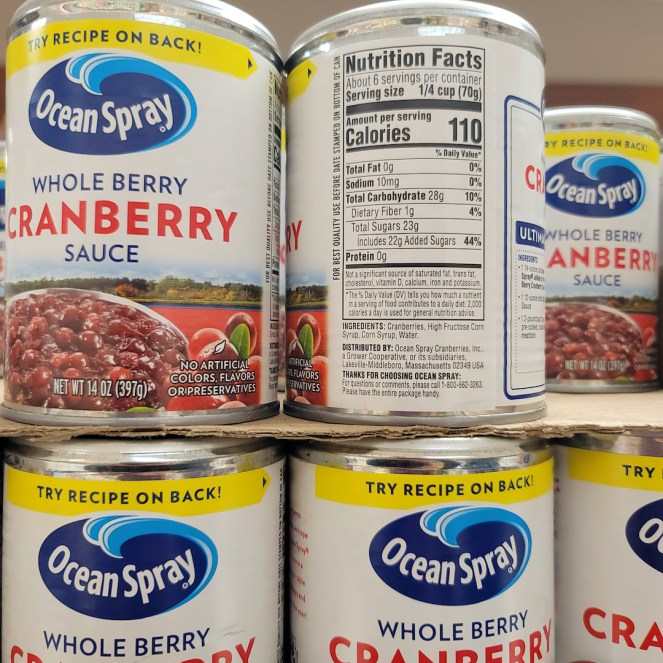Chances are you might be planning on making cranberry sauce from scratch this fall, for Thanksgiving and Christmas dinners. If you have a few more minutes, can a big batch of it instead. Then you have plenty to have on hand, but in small enough portions it won’t spoil in the fridge. And you’ll have plenty to use on turkey sammies this winter into spring.
And compared to commercial canned cranberry sauce, this is so much better. While fresh cranberries are not as cheap as in past years, you can find bags for $2.50 to 3.50 for each 12-ounce package. I spent $5.00 for 24 ounces, to make the batch. A commercial can is usually 14 ounces and retails for $1.50 to 4.00 a can, spending on brand (name or store brand) and if on sale.

So for my time I got 3.5 cans worth canned up. Where I shop the cans average $3 each, unless on sale as it is this week, for $1.99. So maybe I didn’t save a ton, but it was still cheaper.
And let’s be reeeeaaaaal honest here: Mine had less sugar, and there is ZERO corn syrup in mine. It is priceless to have food made with real ingredients.
“Cranberries, High Fructose Corn Syrup, Water, Corn Syrup.”
And while not calling out any specific company, due to the newer USDA guidelines on bioengineered ingredients, most cranberry sauce contains GMO’s, or as it’s known now “BE” (bioengineered) ingredients.
Now then……

This company doesn’t reveal it on their cans, if it contains bioengineered ingredients. It doesn’t have a QR code for Smart Label. Just a phone number.
And yes, I CALLED that hotline. And I hate making phone calls. I asked and was told that the HFCS makes it bioengineered by the company. I am not saying their name, as they have mean lawyers. But I did my work and got an answer.

The only one this store had that was corn syrup free was the private label “Wild Harvest” organic sauce, which uses sugar. The private label “Food Club” is corn and HFCS, and while they have Smart Labels, the labels are not complete when you click on the link.
I’d say right there that making your own cranberry sauce is priceless. Because if you want to avoid HFCS, and GMO’s, you need to make it yourself, and use only cane sugar. C&H carries the 3rd party Non-GMO Verified. 99% of all beet sugar is a GMO crop. So yes, buy brand name with sugar or use organic.
This recipe follows current canning methods and is not rebel canning. Cranberry sauce is nothing more than jam and is an easy intro into water bath canning.
Canned Cranberry Sauce
Ingredients:
- 2 12-ounce bags fresh cranberries
- 1½ cups water
- 4 4″ cinnamon sticks
- ½ tsp ground allspice
- ¼ tsp ground cloves
- 4½ cups granulated sugar
Directions:
Thoroughly wash the cranberries and drain well.
Place 7 8-ounce canning jars into a canning pot rack, place in the canning pot. Fill the jars with water, and fill with water to the top of the jars. Bring to a boil covered over high heat.
Place the lids and rings in a small pot, cover with water and bring to a simmer. Turn off the heat.
In a stockpot (stainless steel or non-stick) add the cranberries, water, cinnamon sticks and spices.
Bring the berries to boiling over hight heat, periodically mashing the cranberries with a potato masher to help break up.
Once boiling, stir in sugar (be careful as the cranberries are hot).
Bring back to a full rolling boil, that you cannot stir down, and cook for about 5 minutes, until the sauce starts to set (it will be thickened if you spoon up). Stir constantly as it cooks, lowering the heat as needed so it maintains a boil but isn’t spitting on your hand.
Take off the heat, remove and discard the cinnamon sticks.
Drain the jars, place on a clean kitchen towel.
Sterilize a canning funnel and a ladle in the hot water, stir the cranberry sauce again and ladle hot sauce into the jars, leaving a ¼” headspace. Use a bubble popper or a chopstick to stir each jar gently, to pop any bubbles. Wipe the jar rims with a new paper towel, dampened with hot water.
Place a new canning lid on each jar, screw on bands until finger tip tight.
Place jars into canning rack, lower into the water, place cover on. Bring back to a boil, process for 10 minutes, starting timing once water boils.
Turn off heat, take off lid, and let rest for 5 minutes.
Remove jars, place on a cooling rack covered with a kitchen towel. Let cool, listening for the pings of the lids. Once cool, check the lids by pressing gently in the middle. If any spring back, put in refrigerator and use within a week.
Made 7 8-ounce jars.
Store in a cool, dry area for up to a year. And enjoy knowing what you are eating. Truly.

~Sarah


















